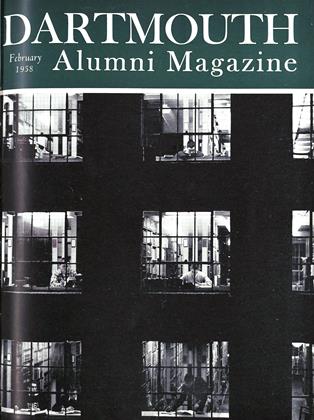1910: An outdoorsman named Fred Harris '11 organized a winter field day, students applied axes and saws to a few hefty trees, prizes were awarded, and the Dartmouth Winter Carnival was on its way.
1958; A member of Palaeopitus named Dick Stoddart '5B presided over an organizational board, the DOC built a 40- foot statue in the middle of the green, eight ski teams arrived to try their luck on the new Dartmouth Skiway, everyone procured a date, and the coldest college weekend in the country once again looked forward to a roaring success.
Thus it is that Winter Carnival, through 49 years of distinctive history, has become a cherished tradition with Dartmouth. mouth.With the exception of 1918, when a coal shortage cancelled weekend plans, Carnival has always emerged in February as an antidote for exam-weary undergraduates and their starry-eyed companions.
There have been threats to the wintry warwhoops - notably in 1917 when rain turned Hanover into'a Robin Refuge, and in ig§3 when the President of the WCTU delivered a prohibition ultimatum - but always student spirit and determination produced a show which sometimes inspired, sometimes enervated, but always impressed anyone in Hanover the first week in February.
This winter extravaganza has undergone tremendous change since its inception in 1910. Outdoor Evening appeared on the scene as an annual affair about 1921, shortly followed by the crowning of the Queen of the Snows in 1923. Mae West's refusal to appear in 1935 on the grounds that "I like my sleigh rides in sedans," and the somberness of Worle War II caused the Carnival collaborator to pause, but they came back stronger than ever in 1947.
Things remained pretty much static from this time until 1953 when it was realized that Dartmouth's winter weekend had become a snowbound coming-out party for most of the undergraduates on the eastern seaboard. In an attempt to limit the number of outsiders and try to preserve Carnival for the College cominunity, the Interdormitory and Interfratetnity Councils issued a limited number of guest cards to students from other colleges.
This procedure helped to solve one of the major weekend problems, but it became increasingly apparent that Carnival had grown beyond the specific realm of the Outing Club, and that organizational revision was necessary to insure its continued success.
In 1956, at the request of President Dickey, a group of College administrators studied the problem and recommended a solution, which was eventually accepted by the Administration and Palaeopitus.
Under the new organization, Palaeopitus annually appoints one of its members to act as president of a Carnival Board. The Board itself is composed of men in charge of various committees, six in all, on whom falls the brunt of the work necessary for a successful Carnival.
Although the Outing Club retains responsibility for events with which it has always been concerned, such as the center- of-campus statue, the Queen contest, and Outdoor Evening, the other committees were established to handle things which are beyond the specific realm of the DOC, yet which it had been forced to handle in recent years. These groups are concerned with housing, feeding, and traffic, fraternity and dormitory activities, public relations, and special events.
Although several kinks appeared in this organization when it first became operative last year, it proved to be a most satisfactory system for transforming Carnival from its status as a DOC-sponsored affair to a weekend staged by the collective efforts of the entire undergraduate body
So it is that Winter Carnival looks back on 49 years. It is certainly a great deal larger than Fred Harris's experiment, and it may have altered in organization, but the spirit is the same.
Snow is a necessity for a really memorable Carnival, and as this is being written that prayed-for ingredient is silently falling outside.
Carnival poster winner for 1958 is Fred C. Scribner III '59 of Portland, Me., son of Fred C. Scribner Jr. '30, who is Under Secretary of the U. S. Treasury.
 View Full Issue
View Full Issue
More From This Issue
-
 Feature
FeatureWhat Makes a College New?
February 1958 By BANCROFT H. BROWN, B. P., JOHN. NASH '60 -
 Feature
FeaturePsychology at Dartmouth
February 1958 By CHARLES LEONARD STONE '17 -
 Feature
FeatureFastest Man on Skis
February 1958 By BOB ALLEN '45 -
 Feature
FeatureRegional Leaders Named for Campaign
February 1958 -
 Class Notes
Class Notes1918
February 1958 By ERNEST H. EARLEY, W. CURTIS GLOVER, RICHARD P. WHITE -
 Class Notes
Class Notes1936
February 1958 By JOHN A. SAWYER, FRANK T. WESTON
Article
-
 Article
ArticleWHO'S WHO IN THE FACULTY
January, 1925 -
 Article
ArticleCongratulations, Players!
JANUARY 1929 -
 Article
ArticleThe Biology of Post-Traumatic Stress Disorder
MARCH 2000 -
 Article
ArticleFreedom Fighter
SEPTEMBER | OCTOBER 2014 By ANDREA USEEM '95 -
 Article
ArticleTrack
January 1957 By CLIFF JORDAN '45 -
 Article
ArticleThe College
November 1978 By Professor Charles Emerson, 1890

